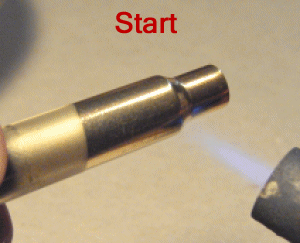I just looked over some load testing that I had done on some USGI NEW Brass which I got some years back from Jeff Bartlett. It's RA 64 new. I was shooting it in my SA Inc. Super Match and also tried a little in my other Super Match. I'm getting some small neck splits on some of the brass on the first firing. I've never had a split neck before. The splits are just starting and are only up to about .070" long at most (approximately). It's showing splits in both rifles. I'll get about 2-3 or so splits per 10 round batch, sometimes 0, maybe more at times. I've done nothing out of the ordinary in reloading. It's just had the necks run over the expander in a die to round the necks up and has had the primer pocket uniformed and the crimp removed with my Superswage. The tar sealant had to be cleaned out of the neck and that was not simple. It was also washed after working the cases to get the case lube off, then loaded. I'm not crimping. These were to be loads for Highpower Competition. I'd say that it's going to be load once and toss, unless someone has any other ideas. I don't know if I'd try annealing. Any help with why these necks might be splitting, or whether any others have noticed this with this lot of brass would be appreciated. I'd really appreciate just about any discussion on this. It would help.
Thanks,
DannyInformation

Warning: This is a relatively older thread
This discussion is older than 360 days. Some information contained in it may no longer be current.
- Knowledge Library

- MKL Entry of the Month
- Australia
- Austro-Hungarian Empire
- Canada
- Czechoslovakia
- Denmark
- Finland
- France/Belgium
- Germany
- Italy
- Japan
- Norway
- Russia
- South America
- Sweden
- Switzerland
- Turkey
- United Kingdom
- United States
- Yugoslavia
- Is my rifle authentic or a fake?
- Jay Currah's Lee Enfield Web Site
- On-line Service Records (Canada)
- Technical Articles/Research
- Forum
- Classifieds

- What's New?
-
Photo Gallery

- Photo Gallery Options
- Photo Gallery Home
- Search Photo Gallery List
-
Photo Gallery Search
- Video Club

- iTrader










 Register To Reply
Register To Reply






